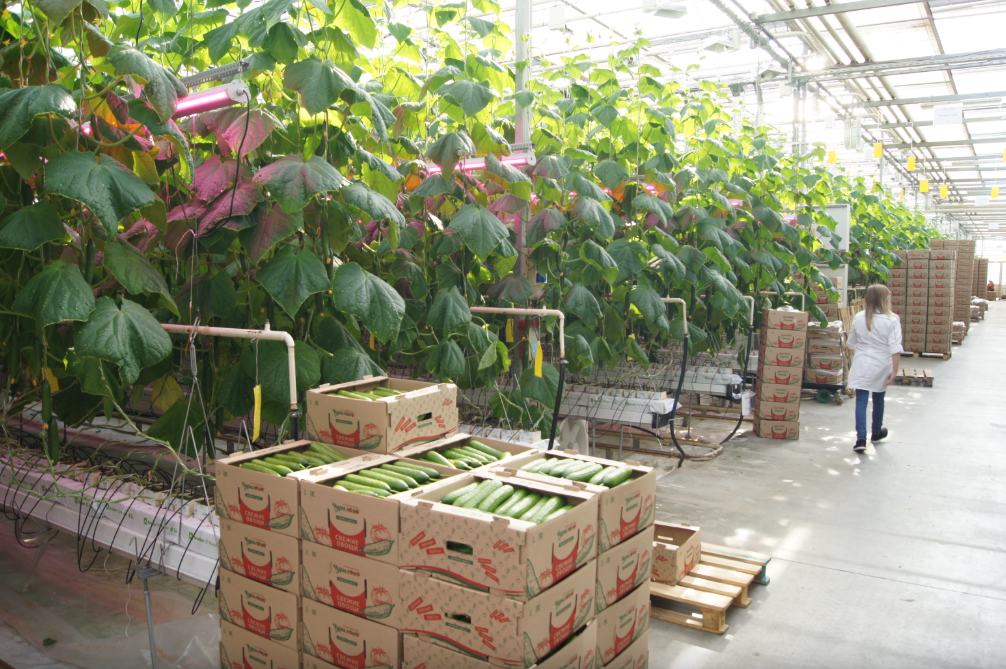why led interlighting is important for high-density vine crops in greenhouse
Cucumbers and tomatoes are two common vine crops of high value in greenhouse. Although they are of different varieties, they are both high-density crops. High density crops, growing to a certain extent, (such as in the later stage of vegetative growth and all growth periods after this phase) will shade each other. though many growers has used trellises,scaffolding or similar supports to make them able to erect growth in the process of growth, such measures are not enough to eliminate or weaken the mutual shading effect on the yield of crops.
You must have thought why not increase the spacing distance of the high-density crops to minimize shading effect? that's normal. Whether you do your own experiments or learn from other planting practices, the truth is that each crop has an optimal range of cultivation intervals within which it can maximize the yield. blind expansion of planting spacing is likely to reduce the yield instead of increasing it . and this probably increase your horticulture investment risk to some extent.
So are there other ways we can do to increase the production?
in fact , the light intensity high-density vine crops like tomato, cucumber and pepper receive decreases with the decline of canopy height . As light is absorbed by younger leaves at the top canopy and the shading effect reduces the light available to lower leaves. so productivity is less than the crops' full potential. in other words , if the illumination of lower canopy is treated ideally,it is very likely that the crop yield will be greatly improved and the production potential will be enlarged to the full . so to maximize the yield of plants, an interlighting grow light is important for high density vine crops since it can provide enough light for the lower canopy.
The problem of insufficient lighting in the lower canopy was noticed by greenhouse growers long before the advent of led grow light, when traditional HID and HPS were prevalent in greenhouses. Growers have ever tried to improve the downward penetration of light by changing the distance between the lamp and the top of the plant, but the result disappointed them much . because the crop leaves were damaged due to the close distance and the high heating radiation from these two kinds of lamps. It wasn't until the development of LED that the possibility to place lighting products more closer to crop leaves was raised.
In the early days of the popularity of led grow light, The original idea was to change the power of the lamp rather than to change the distance between the lamp and the crop to improve the ability that light permeate to the lower canopy. many growers were recommended to use high-power top led grow light as supplementary lighting to plant vine crops in greenhouse. There are three accepted reasons why the high-power grow light is recommended.one is that they hope the vine crops can fully carry out photosynthesis; the second is they hope to compensate for the lack of light in the lower canopy with high power, which is based on the assumption that there is a positive correlation between high power and light permeability.the third is they hope deal with the illumination equalization problem with one light which can help reduce invested cost. It is undeniable that there is a positive correlation between high power and optical permeability. But the production boost from this relationship is limited. The lower canopy of high-density vine crops is still not adequately illuminated.
Generally, interlighting alone are not used to provide supplemental light to greenhouse crops. Top lighting and interlighting are the perfect combination of supplementary lighting for high-density vine crops.

If only the top canopy of crops is illuminated by sunlight or led grow light, according to our previous analysis, the illumination of the lower canopy is insufficient.on the contrary,If only interlighting is installed, though plants can get sunlight through the greenhouse's skylight, photosynthesis is inadequate. there are clear signs that the plants will do further photosynthesis when growers continue to supply artificial light on the basis of natural light.
By using interlighting, the light intensity in the lower canopy increases, allowing older, but still fully functional and productive leaves to photosynthesize more and increase subsequent fruit yield.
Ultimately the decision is yours.all questions will return to the allowable budget and the weigh in whether the cost of an additional interlighting is worth the investment and create more profits .There have already been a number of large greenhouse plant factories to supplement interlighting to increase crop yields as far as we know. For example , RIAT, an innovative Russian agribusiness. Le Jardin de Rabellais and Tomwest in France, Wim Peters Kwekerijen in In the Netherlands,Fri-El greenhouse in Italy etc.

